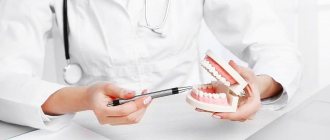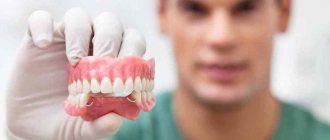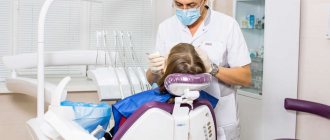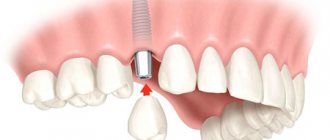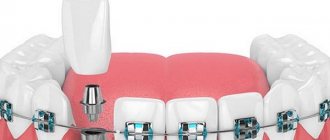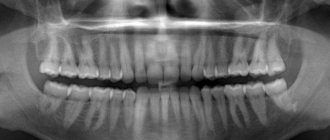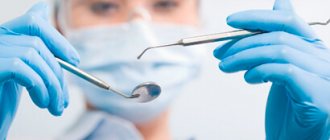Unbearable toothache, sore gums and bad breath require urgent attention from a dentist so as not to aggravate an existing problem.
The initial appointment is carried out by dental therapists. This is a sought-after specialization, since these doctors treat common pathologies of the gums, teeth and oral tissues. A general dentist has a broader range of expertise than a highly specialized orthodontist or surgeon. Such dentists eliminate periodontitis and periodontal disease, relieve pathological changes in the functioning of the salivary glands, treat cheilitis and glossitis (inflammation of the lips and tongue)
A dental therapist not only fills root canals, treats gums or removes tartar. A dentist works to study problems in the maxillofacial area and develop new methods to overcome them.
What diseases does a dentist treat?
At our Dynasty family clinic, dentists practice an individual approach to each patient, depending on the type, origin and dynamics of the disease, and the level of pain threshold.
The main tasks solved by a dentist-therapist:
- Diagnosis and determination of the causes of inflammation, treatment of periodontal disease, periodontitis, periodontoma, gingivitis and periodontitis;
- Treatment and prevention of caries (removal of tartar by the dentist and filling of canals);
- Restoration of mechanical damage to teeth (cracks, chips);
- Elimination of diseases of non-carious origin (pigmentation/erosion or enamel hypoplasia, fluorosis, pulp opening, amelogenesis, root fractures, dentinogenesis, odontogenesis).
At the Dynasty clinic, the dentist-therapist also carries out aesthetic restoration, which allows you to solve all problems within one office, without the involvement of an orthopedist. Without leaving the therapist’s chair, you can restore the front side of the surface of your teeth in two hours using veneers and lumineers (onlays for a “Hollywood smile”) - painlessly, quickly and effectively.
Case 2. Perforation of the tooth canal.
Also often referred to are patients whose tooth canal was unfilled and treated by the so-called. “blindly”, without sufficiently enlarging the surgical area. In this case, the dentist’s instrument could come off the hard material of the canal and cause damage to the root canal - perforate it. In this case, two foci of inflammation occur:
- the first focus of inflammation occurs at the root apex due to an untreated root canal,
- the second focus of inflammation occurs in the area of canal perforation.
The doctor recommends tooth extraction, but in such a situation it is also possible to avoid extraction and save the tooth!
How to do it right:
Contact a clinic that uses a powerful dental microscope in medical practice. Is the tooth removed in this case? - No.
Using a dental microscope, the doctor can look into the root canal, see all the filling material, carefully remove it, unfill the root canal, treat the perforation area, reach both sites of inflammation, eliminate the inflammation and fill both the canal and the previously caused perforation.
Thus, we save the patient’s tooth without resorting to unnecessary removal.
When should you contact a dentist?
Soviet-era people do not like to visit dentists because they are frightened by the strong association with the “scary drill machine” and severe pain. In medical dentistry, therapists use modern methods and equipment to completely anesthetize the process.
A dental therapist will help in cases where:
- During hygienic cleaning of the oral cavity, bleeding is observed;
- The enamel of the teeth has changed shade;
- Eliminates the cause of the unpleasant odor;
- Damage to the oral mucosa requiring intervention by a therapist;
- There is a constant “aching” pain that intensifies when you press on the tooth;
- Carious cavities appeared in the surface of the teeth and they began to react sharply to cold/hot;
- The gums become swollen and red, or new growths appear on them. The dentist will determine the cause of the inflammation and prescribe treatment;
- Teeth receive mechanical damage or have congenital cosmetic defects;
- Constant “wandering” pain radiating to the ear or temple - the help of a dentist is required immediately.
Useful information: It is recommended to visit a dentist twice a year for a routine examination and teeth cleaning with specialized instruments. Using a laser, the dentist removes mineralized deposits on the surface of the teeth, along with pathogenic bacteria. The procedure even allows you to lighten the enamel a little.
How the procedure is performed - extraction options
First, the specialist must examine the oral cavity, select the appropriate anesthesia method and extraction method. In some cases, due to an acute inflammatory process, removal is postponed until the next appointment. In the meantime, the doctor prescribes the patient a course of antibiotics to relieve acute symptoms and normalize the condition.
The operation is performed under local anesthesia. If a patient has a strong, overwhelming fear of dental treatment (dental phobia), deep sedation may be offered to relieve anxiety. In rare cases, the procedure is performed under general anesthesia, but recently experts are more often giving preference to deep sedation as a safer and no less effective alternative.
To extract a tooth from its socket, the doctor may use one of the following techniques:
- simple extraction: using special forceps, the surgeon grabs the crown and then carefully removes it along with the root. Incisors, canines and molars are first rotated, double-rooted molars are swung,
- complex – if the tooth needs to be extracted in parts or the remaining root must be removed. The doctor has to saw the crown and root system, cut out the root using different attachments for a drill, make incisions on the gum if the element is impacted,
- atypical - first, the specialist makes a trapezoidal incision on the surface of the gum and peels off a flap of the mucous membrane to open access to the alveolar socket. Next, he saws the crown and roots with a bur and then carefully pulls them out piece by piece. By the way, the same technique is relevant for cases of fracture of the root apex1.
For simple removal, the doctor uses special forceps.
After removing the tooth from the socket, the specialist carefully cleans the wound from small fragments, treats the tissue with antiseptics and places a sterile swab in the socket. If necessary, applies sutures or fixes the drainage system to ensure the outflow of purulent masses. Finally, the patient receives explanations on how to care for the socket after removal. You can read more about them in our special article.
Cost of dental services
The dentist provides a wide range of services, so prices depend on many factors: the type of disease and the complexity of its treatment; consumables and number of sessions with the dentist.
Basic cost of services:
- Professional cleaning – 170 rubles;
- Treatment of pulpitis and periodontitis – from 550 rubles;
- Elimination of caries – from 300 rubles;
- Chemical whitening of all teeth – 8,000 rubles.
The full list is in the price list on the website.
If you need professional dental help, our clinic offers the services of specialists with many years of experience.
Help from a pediatric dentist-surgeon
A pediatric dentist surgeon is a pediatric doctor whose competence includes various operations in the oral cavity: cutting and plastic surgery of the frenulum of the tongue and the vestibule of the oral cavity, as well as tooth extraction. Children with inflammatory processes, defects in the dentition, jaws or face (requiring surgical intervention) and a number of other diseases, including: jaw cysts and tumors, perimaxillary abscesses, gingivitis, alveolitis, fractures and dislocations of teeth and jaws, fluxes, are referred to this specialist. and many others.
The surgeon works in conjunction with a pediatric dentist and orthodontist, which is very important in the treatment of malocclusion, when permanent teeth do not erupt due to the incorrect position of the tooth in the jaw (impacted tooth) or due to the presence of a supernumerary tooth (extra) that prevents eruption complete normal tooth. Irrational treatment in these situations is fraught with problems with bite, diseases of the temporomandibular joint and early prosthetics of permanent teeth. That is why such developmental anomalies require an integrated approach to treatment.
A frequent situation is when a dental surgeon decides to remove a baby tooth, which in a normal situation would have been in the dentition for a long time, but its preservation is not advisable or is fraught with various complications, such as: the spread of infection to the permanent tooth germ or surrounding tissues .
PHOTO: Low attachment of the frenulum of the upper lip. Such a “short” frenulum of the upper lip does not allow the gap between the central incisors to disappear. The gap between the teeth will go away on its own after plastic surgery of the frenulum of the upper lip.
If a baby tooth is removed 2 years or more before its natural loss, then such removal is considered early. Adjacent baby teeth begin to move into the space created after the early removal of a baby tooth, which creates the preconditions for the formation of a malocclusion. For example, the removal of the 5th milk tooth (second baby molar) at the age of 6 is considered early, since this tooth should be in the dentition until the age of 12. After early removal of baby teeth, the participation of a pediatric orthodontist is required to make a special space retainer to prevent the development of malocclusion in the child. In the case of early removal of primary incisors, it is often necessary to make a removable denture with teeth to prevent the child from developing speech therapy problems (lisp).
Useful recommendations for oral care from a dentist
The dentist promotes caries prevention and gives basic advice:
- Maintain good hygiene (brush your teeth after eating and floss);
- When brushing, do not forget about your tongue, because germs accumulate on it first;
- Limit your consumption of carbonated and coloring drinks, chips, candies and candies;
- Get a preventive examination at the dentist.
A dental therapist is able to prevent diseases and treat them at an early stage, which will help avoid many problems.
To make an appointment, call the phone numbers listed on the website or use the feedback form.
How is the diagnosis performed at the initial appointment with an orthopedic dentist?
Modern dentistry allows almost all manipulations to be performed painlessly for the patient. At the same time, some people who have had bad experiences in the past are afraid of visiting clinics. Most often, they prefer to know in advance what a specialist will do in order to mentally prepare not only for the procedures, but also for the initial examination, during which the diagnosis is made. If you are planning to visit a prosthetist for the first time, be prepared for the following stages of interaction:
- Basic: Questioning to collect anamnesis
. Here the specialist asks questions that will help you individually choose a method for solving the problem. - Facial examination
. To study the size of the mouth gap, possible shortening of the lower part of the face and asymmetry, features of the setting of the lips and chin. The tone of the lip muscles is also determined by palpation. - Oral examination
. The bite, shape, size and condition of existing teeth are carefully examined. The condition of the mucous membrane, the individual nuances of the formation of the frenulum of the lips are also assessed, the shape and span of the tongue, the arch of the hard palate and the general development of the jaws are studied. - X-ray
. Radiography allows you to assess the condition of the supporting units, as well as identify the presence of impacted and other special elements that cannot be detected without photographs.
(may be needed for a deeper study and accurate diagnosis):
- functional chewing samples are taken;
Based on the results of the main and additional examination, the specialist makes a diagnosis and develops individual treatment tactics. Knowing who an orthopedic dentist is, in what cases you should contact him and what he will do when you arrive at your appointment, visiting dentistry will not be so scary. And since the initial examination is absolutely painless and without discomfort, it makes sense to at least sign up for a consultation in order to understand the condition of your teeth and whether it is possible to save those about which you have complaints.


